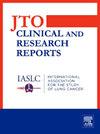A Multicenter, Retrospective, Real-World Study of Atezolizumab Plus Chemotherapy and Pembrolizumab Plus Chemotherapy for Older Patients With NSCLC
IF 3.5
Q2 ONCOLOGY
引用次数: 0
Abstract
Introduction
Evidence of immune checkpoint inhibitors (ICIs) combined with chemotherapy for older patients with NSCLC is limited. This real-world study compared the efficacy and safety of atezolizumab plus chemotherapy (ACT) with those of pembrolizumab plus chemotherapy (PCT) for older patients with advanced nonsquamous NSCLC.
Methods
This multicenter, retrospective study included 288 patients 65 years or older with advanced or recurrent nonsquamous NSCLC who received PCT or ACT as first-line treatment at 13 institutions in Japan. After one-to-one propensity score matching, overall survival (OS), the incidence of grade 3 or higher treatment-related adverse events, and all-grade pneumonitis of the PCT and ACT groups were compared.
Results
After propensity score matching, 54 patients were included in each of the groups. OS did not significantly differ between the PCT and ACT groups. The median OS was 16.6 months for both groups. Compared with the PCT group, the ACT group had a hazard ratio of 1.09 (95% confidence interval [CI]: 0.68–1.74; p = 0.7). Grade 3 or higher adverse events occurred in 40.7% and 33.3% of patients in the PCT and ACT groups, respectively (p = 0.55). The incidence of treatment-related pneumonitis of the PCT group was significantly higher (29.6%, including 11 grade ≥3 cases) than that of the ACT group (5.6%, including two grade ≥3 cases) (p = 0.002).
Conclusions
ACT may be associated with a more favorable safety profile than that of PCT for the Japanese population; therefore, ACT could be considered a treatment option for older patients with advanced nonsquamous NSCLC.
Atezolizumab联合化疗和Pembrolizumab联合化疗治疗老年NSCLC患者的多中心、回顾性、真实世界研究
免疫检查点抑制剂(ICIs)联合化疗治疗老年非小细胞肺癌的证据有限。这项现实世界的研究比较了atezolizumab加化疗(ACT)和派姆单抗加化疗(PCT)对老年晚期非鳞状NSCLC患者的疗效和安全性。方法本多中心回顾性研究纳入了288例65岁及以上晚期或复发性非鳞状NSCLC患者,这些患者在日本13家机构接受了PCT或ACT作为一线治疗。一对一倾向评分匹配后,比较PCT组和ACT组的总生存率(OS)、3级及以上治疗相关不良事件发生率和全级别肺炎。结果经倾向评分匹配后,两组共纳入54例患者。PCT组和ACT组间OS无显著差异。两组的中位OS均为16.6个月。与PCT组相比,ACT组的风险比为1.09(95%可信区间[CI]: 0.68-1.74; p = 0.7)。PCT组和ACT组3级及以上不良事件发生率分别为40.7%和33.3% (p = 0.55)。PCT组治疗相关性肺炎的发生率(29.6%,包括11例≥3级)显著高于ACT组(5.6%,包括2例≥3级)(p = 0.002)。结论:在日本人群中,sact可能比PCT具有更有利的安全性;因此,ACT可以被认为是老年晚期非鳞状NSCLC患者的一种治疗选择。
本文章由计算机程序翻译,如有差异,请以英文原文为准。
求助全文
约1分钟内获得全文
求助全文
来源期刊

JTO Clinical and Research Reports
Medicine-Oncology
CiteScore
4.20
自引率
0.00%
发文量
145
审稿时长
19 weeks
 求助内容:
求助内容: 应助结果提醒方式:
应助结果提醒方式:


